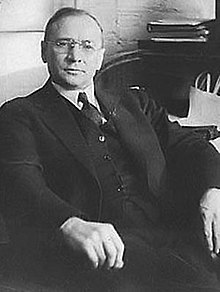Vladimir Zworykin
| Vladimir K. Zworykin | |
|---|---|

Vladimir Zworykin in 1956
|
|
| Born |
Vladimir Kosmich Zworykin July 29, 1888 Murom, Vladimir Governorate, Russian Empire |
| Died | July 29, 1982 (aged 94) Princeton, New Jersey, U.S. |
| Citizenship | Russian, American |
| Education |
Saint Petersburg State Institute of Technology ESPCI University of Pittsburgh (PhD) |
| Spouse(s) | Tatiana Vasilieff (m. 1915) 2nd wife Katherine Polevitsky (m. 1951) |
| Engineering career | |
| Projects | Television, Electron Microscope |
| Significant design | Iconoscope, Photomultiplier |
Vladimir Kosmich Zworykin (Russian: Влади́мир Козьми́ч Зворы́кин, Vladimir Koz'mich Zvorykin; July 29 [O.S. July 17] 1888 – July 29, 1982) was a Russian inventor, engineer, and pioneer of television technology. Educated in Russia and in France, he spent most of his life in the United States. Zworykin invented a television transmitting and receiving system employing cathode ray tubes. He played a role in the practical development of television from the early thirties, including charge storage-type tubes, infrared image tubes and the electron microscope.
Vladimir Kosmich Zworykin was born in Murom, Russia, in 1888, on July 29 (old style July 17), to the family of a prosperous merchant. He had a relatively calm upbringing, and he rarely saw his father except on religious holidays. He studied at the St. Petersburg Institute of Technology, under Boris Rosing. He helped Rosing with experimental work on television in the basement of Rosing's private lab at the School of Artillery of Saint Petersburg. They worked on the problem of "electrical telescopy," something Zworykin had never heard of before. At this time, electrical telescopy (or television as it was later called) was just a dream. Zworykin did not know that others had been studying the idea since the 1880s, or that Professor Rosing had been working on it in secret since 1902 and had made excellent progress. Rosing had filed his first patent on a television system in 1907, featuring a very early cathode ray tube as a receiver, and a mechanical device as a transmitter. Its demonstration in 1911, based on an improved design, was the first world's demonstration of TV of any kind.
Zworykin graduated in 1912 and, thereafter, studied X-rays under professor Paul Langevin in Paris. During World War I, Zworykin was enlisted and served in the Russian Signal Corps, then succeeded in getting a job working for Russian Marconi, testing radio equipment that was being produced for the Russian Army. Zworykin decided to leave Russia for the United States in 1918, during the Russian Civil War. He left through Siberia, travelling north on the River Ob to the Arctic Ocean as part of an expedition led by Russian scientist Innokenty P. Tolmachev, eventually arriving in the US at the end of 1918. He returned to Omsk, then capital of Admiral Kolchak's government in 1919, via Vladivostok, then to the United States again on official duties from the Omsk government. These duties ended with the collapse of the White movement in Siberia at the death of Kolchak. Zworykin then decided to remain permanently in the US.
...
Wikipedia
